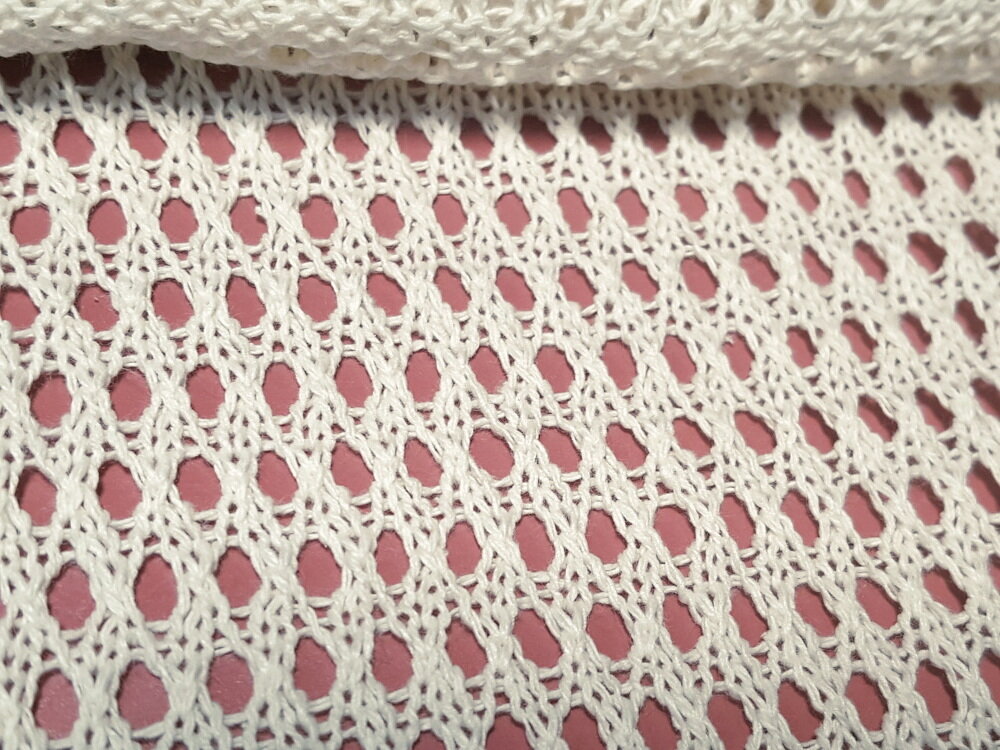A Little Lace
“Lace is composed of three elements: openings, lines, and solid areas,” state Susanna Lewis and Julia Weissman in A Machine Knitter’s Guide to Creating Fabrics. Frankly, my experience with “true” lace, the type made by transferring stitches laterally, is limited. Creating those openings means making transfers, and transfers can be tedious on a hand knitting machine. Before Kniterate, I stayed away.
Over the years I’ve admired the beautiful knitted lace made on hand knitting machines. Decades ago I owned a Singer 360 which could transfer a stitch to an adjacent needle and knit it in one carriage pass, but I had no interest in knitting lace at that time.
Later, with my Passap I was able to make cross bed transfers with the special transfer carriage. The transfer carriage was useful for many knitting sequences. Lace made with cross bed transfers is fun to knit, but I didn’t knit that type of fabric often.
Lateral transfer lace on the Passap is something I never knitted. That type of lace is made on the Passap the same way it’s made on an industrial machine, and there are many moves for little gain. To execute the lateral transfer, all stitches on the front bed are first transferred to the back bed. (Though ribs can be added creatively, the stitches are generally knitted on one bed.) The back bed, now holding all the stitches, is racked either left or right one pitch. Selected stitches are then returned to the front bed in their new positions. Depending on how complex the lace is, it can take a few moves to transfer both left moving and right moving stitches to their new needles on the front bed. The last transfer is to return the “stationary” stitches to their original needles on the front bed. All stitches are now in place to knit the row. (I recently heard this method is similar to the Schoolbus algorithm. Get it?)
I’ve usually knitted my lacelike fabrics without transfers—just a little racking, multiple tucks, and a few needles left out of work. Below are samples I knitted on a Dubied (left, closeup) and a Passap.
With the Kniterate’s programmable back to front and front to back transfers available during both right and left carriage traverses and with gorgeous Instagram inspo from @plasmatopian, I decided it was time for me to finally dip my toe into true lace knitting.
My first warmup swatch (below, left) lacked solid areas that Lewis and Weissman describe. It was a 1x1 mesh, not what I consider to be lace. I made all transfers in the same direction. You can see the resulting bias in the swatch.
With the second warmup swatch (above right and below) I introduced some solid areas and I alternated the direction of the transfers. Mostly, however, I was experimenting with the transfer sequence. I described the usual method for making a lateral transfer on an industrial machine above. For this second swatch, instead of beginning by transferring all stitches to the opposite bed, I only transferred the stitches that would eventually move to their adjacent needles. This worked, I believe, because there wasn’t much stress on the fabric as it was a single transfer pattern; that is, just one consecutive stitch had to be transferred for this particular stitch pattern. Though this meant fewer transfers altogether compared with the usual method, using this shortcut placed the stitches in the incorrect order on the receiving needle. It’s not noticeable with a 1x1 stitch pattern, but it would be obvious with something more complex.
To knit the butterscotch swatch (below and top of page) with multiple transfers, I used the Schoolbus. Though I plan to develop my own complex lace patterns at some point, for my first real attempt at true lace on a Kniterate I borrowed a stitch pattern from the Big Book of Knitting Stitch Patterns, originally published as Punti Della Maglia, edited by Ellen Liberles.
As a machine knitter with little handknitting experience, the knitting instructions in the book meant nothing to me. Fortunately, straightforward charts were also provided. Because the simplest lace stitch patterns were easy for me to decipher, I was able to transfer one I particularly liked, Overlapping Waves, to the Kniterate design app. I don’t consider multiple transfers an issue when they’re done automatically, but I should have considered how many lines of instructions would be devoted to transfers and started with a longer panel size setting in the design app. Many transfers with few knitted rows yield just a little lace!
O!
As a Kniterate ambassador I’d be happy to give you a virtual tour of the machine. If you’re a Kniterate owner, you may be interested in my prerecorded Designing with Kniterate classes.





